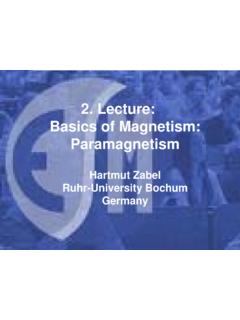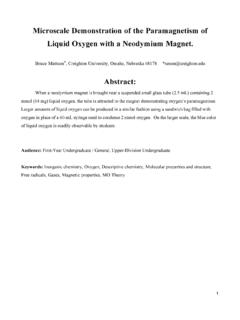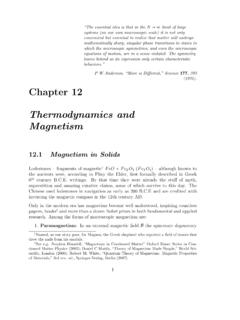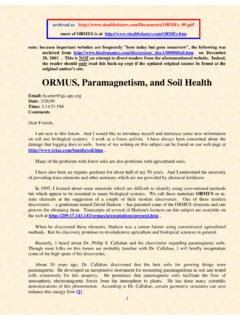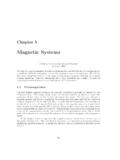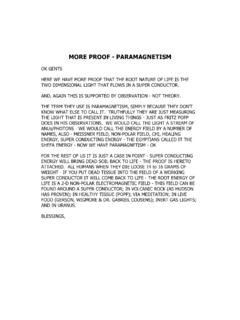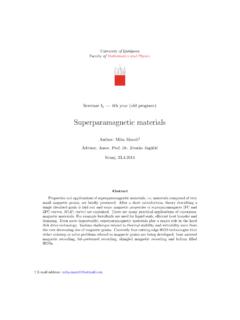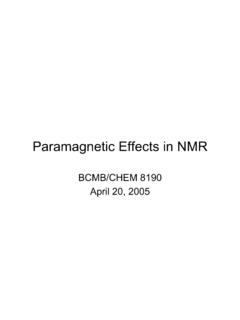Transcription of Chapter 6: Introduction to Molecular Magnetism and Crystal ...
1 Chapter 6: Introduction to Molecular Magnetism andCrystal IntroductionThe control of bulk magnetic properties has proven to be extremely difficult (Carlin,1986; Kahn, 1993; Miller and Epstein, 1994; Turnbull et al., 1996). This is in part due tothe many different types of magnetic behaviors that have been characterized. At leastfourteen different magnetic behaviors have been identified in solids (Hurd, 1982). Thesedifferent magnetic behaviors arise from the various spin-spin interactions observed inthese materials. The complexity associated with controlling magnetic properties hasarisen from difficulties in controlling the spatial arrangement of spin containing we provide an Introduction to bulk magnetic behaviors, describe several strategiesfor controlling spin-spin organization, and expand on one of these strategies, crystalengineering.
2 Later chapters and appendixes, in this section, provide examples ofdifferent magnetic materials that take advantage of the methods discussed here to controlspin-spin MagnetismMagnetic materials play critical roles in our daily lives. Magnetism was first discoveredby the ancient Greeks and used by the Chinese to create a south pointing compass(Mattis, 1981). Since the invention of the compass, the number of devices that usemagnetic components has skyrocketed. A small number of the applications of magneticmaterials include frictionless bearings, medical devices, magnetic separators,loudspeakers, microphones, switches, sensors, data storage devices, motors, andgenerators (Miller and Epstein, 1994).
3 The extensive commercial viability of magneticmaterials has driven research in this magnetic materials are two- and three-dimensional arrays of inorganic atoms,composed of transition metal or lanthanide metal containing spin units. These materialsare typically produced at very high temperatures using metallurgical methodologies. Incontrast to traditional magnetic materials, Molecular magnets are organic orinorganic/organic hybrid materials, comprised of either metal containing spin units ororganic radical containing spin units. It has been postulated that these materials willallow for the low temperature synthesis of magnetic materials, materials with betteroptical properties, the combination of magnetic properties with mechanical, electrical,and/or optical properties, better control over a material s magnetic characteristics, andmaterials that can be easily processed (Miller and Epstein, 1994).
4 In order to design materials with interesting bulk magnetic properties it is necessary tounderstand how bulk Magnetism arises in samples. A complete understanding ofmagnetism has not yet been formulated, however many of the general principles ofmagnetic behavior are well established. Some of those principles are reported Diamagentism and paramagnetism (Carlin, 1986; Kahn, 1993)On the atomic level there exist two fundamental types of Magnetism : diamagnetism andparamagnetism. All of the more complex magnetic behaviors which are observed evolvefrom these basic magnetic behavior is characterized by repulsion of a substance out of an appliedmagnetic field.
5 This behavior arises from the interaction of the applied magnetic fieldwith Molecular or atomic orbitals containing paired electrons. With the exception of thehydrogen radical, all atomic or Molecular materials exhibit some diamagnetic magnetic behavior is temperature independent, and the strength of the interaction isroughly proportional to the Molecular weight of the is characterized by the attraction of a substance into an applied magneticfield. This behavior arises as a result of an interaction between the applied magnetic fieldand unpaired electrons in atomic or Molecular orbitals. Typically, paramagneticmaterials contain one or more unpaired electrons, and the strength of paramagneticinteractions are temperature dependant.
6 However, some substances exhibit temperatureindependent paramagnetism (TIP) that arises as a result of a coupling between themagnetic ground state and non-thermally populated excited states. TIP has beenobserved for materials with both paramagnetic and diamagnetic ground states, and it isusually associated with electrically conducting , the term Magnetism refers to substances that at the atomic level exhibittemperature dependant paramagnetic behavior and will thus be used in this context. Thenon-zero spin angular moment associated with an unpaired electron gives rises to amagnetic moment. Upon pairing, electrons within an orbital exhibit opposing magneticmoments, resulting in no net magnetic moment.
7 In general, bulk magnetic propertiesarise as a result of long-range interactions between unpaired Cooperative MagnetismBulk magnetic behavior arises from interactions between paramagnetic atoms ormolecules. These interactions can create materials that are either magnetic or non-magnetic, depending on how adjacent magnetic spins align with each other. Over 14different possible magnetic interactions have been described in the literature (Hurd,1982). Several of the important types of magnetic interactions are presented DimensionalityAlthough magnetic interactions occur in three dimensions, the type and strength of theseinteractions can be different in each dimension.
8 This gives rise to magnetic materialswith one cooperative interaction type in one dimension and different cooperativeinteraction types in the other two dimensions. Typically in cases where differentmagnetic interactions are observed due to dimensionality, the material is characterized bythe strongest paramagnetism , Antiferromagnetism, Ferromagnetism, andFerrimagnetism (Carlin, 1986; Kahn, 1993)Generally, the bulk magnetic behavior of a material can be described by one of the fourmajor classes of Magnetism . The major classes of Magnetism are paramagnetism ,ferromagnetism, antiferromagnetism, and ferrimangetism.
9 These classes of magneticbehavior describe how adjacent magnetic moments would interact with each other atabsolute zero. The interactions are shown in Figure and described : The alignment of magnetic moments at absolute zero for the four principle classes ofmagnetism. No alignment of adjacent magnetic moments is observed for paramagnets. Ferromagnetsexhibit parallel alignment of adjacent magnetic moments. Antiferromagnets exhibit antiparallel of adjacentmagnetic moments. Ferrimagnets are composed of two magnetic spins of different strength and exhibitantiparallel In a paramagnetic material each individual electron spin is unaffectedby its neighbors.
10 The spins of a paramagnetic material can easily be aligned by anapplied magnetic field. However the alignment is weak, and upon removal of themagnetic field the system relaxes back to a random distribution of magnetic paramagnetic materials are extremely rare, since most materials exhibit one of theother three principle classes of Magnetism at very low Ferromagnetism is characterized by parallel alignment of adjacentmagnetic spins that results in a large net magnetic moment. Ferromagnetic alignment ofadjacent magnetic spins is rare since it can only be achieved if there is zero quantummechanical overlap between the spin-containing orbitals.

